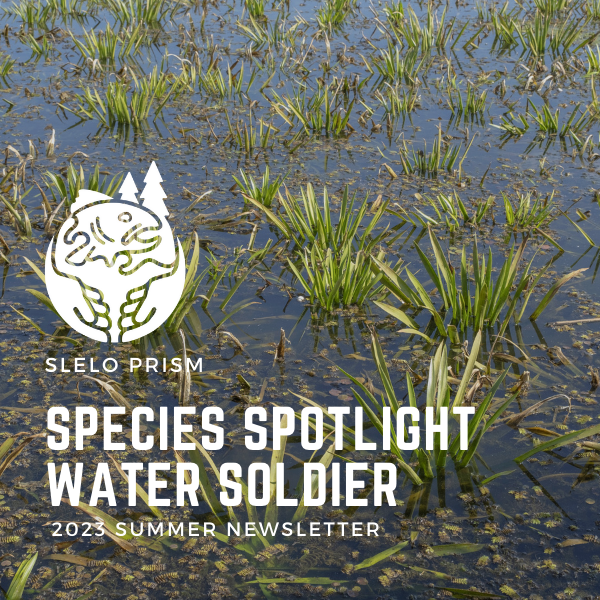This article was featured in the 2023 summer newsletter by Freddie Karotz, SLELO/TILT Watercraft Inspection Steward.
Water soldier has many colloquial names that point to different features of its morphology: saw tooth, water aloe, and water pineapple all refer to the same species, Stratiotes aloides. In the summer, its dark green conical leaves become buoyant, and break the surface of the water to stick up in a rosette that resembles the leaves at the top of a pineapple, complete with serrations along their edges. In midsummer, the plants become waterlogged, and sink below the surface. Flowers are white and have three petals, though budding is rare.

Studies in other areas where water soldier is present, as well as laboratory work, have highlighted the potential detriment caused by the introduction and establishment of water soldier. The plant’s serrated leaves can cut skin easily, becoming a danger to anglers and swimmers. Dense growth of water soldier is an obstacle to boaters, and easily outcompetes native species for space and nutrients. It is also shown that water soldier can alter the chemistry of aquatic systems resulting in negative impacts on phytoplankton and other aquatic invertebrates (Ontario.ca). These chemical and microscopic effects are just as important as visible ones; ecosystems are mutable at every trophic level. A large and sudden change in one species’ population can prompt a series of responses from either the environment itself, or other organisms within it.
Water soldier is native to the UK, Spain, Italy, Bulgaria, Siberia, and most of Asia. It was introduced into Ontario’s Trent River via an accidental garden escape. As of 2009, the population had grown from just a few samples to 22,000, now invading Red Horse Lake and Black River (InvadingSpecies.com).
Water Soldier is seen as a high-risk plant for invasion of the Great Lakes region and SLELO PRISM waterways, as these waters are all connected. Currently, Water Soldier is a Tier 1 Species in SLELO PRISM.
Recently, Water soldier has been detected by commercial fishers at the outlet of the Bay of Quinte. Due to concern for potential spread, the Ontario Ministry of Northern Development, Mines, Natural Resources, and Forestry Surveillance Program is expanding to include Eastern Lake Ontario, and the St. Lawrence River in 2023. Since early spring, no significant additional finds have occurred through this surveillance effort. Control efforts within the Bay of Quinte in Belleville and Trenton will be underway starting in August utilizing a trial with ProcellaCOR aquatic herbicide. You can help stop the spread of water soldier and other aquatic invasive species by cleaning, draining, and drying your watercrafts in transit between all bodies of water. If you come across water soldier be sure to report it to nyiMapInvasives.org and boat slowly in areas where it is present to reduce its spread. For more information on water solder, visit our species profile webpage.



